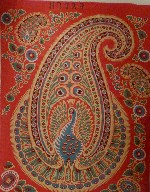Dear Readers:
Welcome to the Winter 2014 edition of the Turkey Red Journal. This is our 19th year of publication and judging from the number of comments, submission and requests in my mail box, a desire for natural dyers around the world to commutate with each other and share ideas is still strong and growing each year.
This year, I traveled with my husband to Scotland to hike the countryside (hillwalking as it is called), taste the local cuisine and of course, visit natural dyers and learn more about historical dyeing in Scotland.
Our first stop was in Edinburgh, where we were introduced to the "Colouring the Nation" project by Dr. Sally Tuckett. Colouring the Nation is a two-year collaborative project between the University of Edinburgh, School of History, Classics and Archaeology and National Museums Scotland, directed by Dr. Stana Nenadic of the University of Edinburgh, with Dr. Sally Tuckett as postdoctoral researcher. The project focuses on the history of Turkey Red dyeing and printing throughout the 19th and 20th centuries. An online exhibition showing images from 200 pattern books owned by the university is available for viewing at www.nms.ac.uk/turkey_red/colouring_the_nation/ about_colouring_the_nation.aspx.
The results of Nenadic's and Tuckett's research are presented in the book Colouring the Nation, which is reviewed is this issue by Scottish natural dyer and educator, Patricia MacIndoe ("A Scottish Colour Kitchen," TRJ Volume 14, Issue 2). Patricia lives near the site of the Turkey Red industry—the Vale of Leven, Dunbartonshire—and works with school groups to educated them on the local history.
In Edinburgh, we also meet with Trisha Gow, another Scottish artist and natural dyer, to learn more about fungi dyeing in Scotland and view some of her beautiful fungi-dyed tapestries. You can view images and learn more Trisha's work in her article "Dyeing to Weave."
On the Isle of Skye, we meet dyer and author Eva Lambert, co-author of The Complete Guide to Natural Dyeing. Eva gave us a tour through her dye production studio, where she and assistants produce naturally dyed yarns for local shops and for export. Eva's article "Shilasdair Yarns" gives us some insight into this successful natural dye business.
Also in this issue is a historical account of the use of natural dyes for tattooing, duk, as it called in India. Although this method of tattooing women is not condoned in contemporary India, Drs. Robindra Teron and SK Borthakur, in their article, "A History of Duk. Facial tattooing with indigo dye of the Karbi women of Northeast India," explain how indigo was used to impregnate the skin with dyes.
"Colours in Laos" tells the story of May Bass' adventure to Laos, where master dyer, Mrs. Phuit, demonstrated dyeing methods in the Sam Tai area.
Using local growing and collected plants, Wendy Feldberg, in her beautiful illustrated article "Eco Printing with Native Plants," encourages dyers to investigate their own local flora to create colors on fabrics.
I will continue to teach natural dye workshops this summer and fall in Chicago area. At the Lurie Garden, in Millennium Park, I will offer a one day participatory demonstration on "Dyeing with Local Flora" on August 19, 2014, from 9:00 AM to 3:00 PM. Registration begins mid-February (www.eventbrite.com/e/free-adult-workshop-dyeing-with-local-flora-registration-10527274361?aff=eorg ). I will also be teaching "Dyeing Local: Creating Color with Berries, Barks, Leaves and Flowers," a four week class at the Chicago Botanic Garden, starting September 15, 2014. Registration begins on April 25 (www.chicagobotanic.org/ education/ arts_and_crafts).
We have moved to an open submission policy for articles, artwork, exhibit notices and reviews for for upcoming issues. We are interested in featuring dyers from around the world, so don't hesitate to submit your ideas for articles. Send your submissions to madder@comcast.net.
Back issues of the print version of the TRJ are still available for purchase. Contact me directly for further information. Please keep sending in your thoughts and suggestions. We appreciate all your comments.
If you are not currently on the TRJ new issue notification mailing list and would like to receive notification when the new issue is online, please send an email to madder@comcast.net. Your email address will not be shared with others.
As always, a special thanks to Bob Feldman, our copy editor and webmaster for all his hard work.
Pamela FeldmanEditor and Publisher
www.pamelafeldman.com
 Turkey Red Journal
Turkey Red Journal
